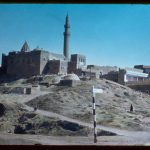Tomb of Jonah in Nineveh, Iraq. Photographic slide film, circa 1950-1970. Image provided by the Matson Collection, LOC and Wiki Commons.
STORY BY ELLIE INGRAM
Everyone told us that we wouldn’t be able to make it in—Americans living in Iraqi-Kurdistan with a desire to walk the streets of Mosul, modern-day Nineveh. Seven years after Mosul was liberated from the reign of Daesh (the locally used Arabic name for the Islamic State group formerly known as ISIS), fewer than 30 humanitarian aid workers live full-time within the gates of Nineveh. Countless others have been turned away from the outskirts of the city via a trifecta of Kurdish, Iraqi, and Iranian-backed militia checkpoints.
However, by traveling with a local tourism company, our group of American sightseers was able to gain access to the city of 1.7 million, located about 400 kilometers north of Baghdad. Our female guide sweetly told the armed Iraqi guards that we wanted to go to the site of Jonah’s tomb to baptize our children there. As we rolled past the checkpoint, I exhaled a sigh of utter relief mixed with perplexed appreciation for Iraqi culture; I had no intention of baptizing my son that day, but our guide’s creative liberty in the name of religiosity seemed to have gained the approval of the Muslim militia.
Mosul is suspended in a world of liminality. Though it is no longer an epicenter of war in the Middle East, entire neighborhoods in the Old City remain frozen in time as if it is still June 2014, when Daesh took Mosul captive and declared the city the epicenter of a new caliphate. Here, bullet shells and piles of rubble sit on doorsteps like pairs of forgotten shoes. The scars of war linger in neighborhoods outside the Old City as well; freshly painted window frames share residence with roofless homes.
The in-between atmosphere of the city is further accentuated by the identity struggle of Mosul’s inhabitants, called Maslawis in Arabic. The ever-looming memory of Daesh juxtaposed with Maslawis’ 3,000-year-old ethnic heritage has created a tug-of-war between Nineveh’s ancient and recent pasts. In the course of one day, I visited both the Gates of Nineveh, built around 700 B.C., and Al-Nuri Mosque, where Abu Bakr al-Baghdadi pronounced Mosul the capital of the Islamic State in Iraq and Syria.
Similarly, though Al-Nuri Mosque hangs over Mosul like a tombstone, the walls of the city are lined with UNESCO community restoration posters. Despite the half-destroyed homes awaiting their inhabitants, the rehabilitation of the Mosul Cultural Museum is fully underway, with the museum set to reopen in 2026. Ultimately, this physical rebuilding of Mosul points to the spirit of Maslawi resiliency that has remained intact in the face of terror.

Map of Iraq, with the location of Mosul. Map provided by Ghada Rzouki Al Slik and ResearchGate.

A rooftop view of the city provides a survey of Mosul’s architecture. Photo courtesy of Ellie Ingram.
Through the trauma they have endured, Maslawis are fiercely independent—considering themselves “of Mosul” first and foremost, elevating their local identity above national and religious affiliations. During my visit, I had the opportunity to meet a local family of 10 living in a two-bedroom apartment once occupied by Daesh. Overjoyed, albeit surprised, to have American visitors in their home, the men sat on floor cushions and drank tea while the women gathered in a corner of the main room and exchanged stories.
The matriarch of the family, “Fatima,” recounted how she had been shot by Daesh and abandoned in a former Pepsi factory, mortally wounded and without water for three days. She ultimately was rescued by a humanitarian aid organization and was given the opportunity to raise her children and see them live another day.
Hearing Fatima’s account of coming back from the brink of death, I was struck by how her story encapsulates the spirit of Mosul today. This second-chance city is a portrait of what it means to pursue flourishing in spite of, because of, and in the midst of life’s ruins.

Despite Mosul’s damaged infrastructure, Maslawis continue with daily life, exhibited in how this car is parked under a crumbling rooftop. Photo courtesy of Ellie Ingram.

The ruins of Al-Nuri Mosque in Mosul, summer 2019, after its destruction by Daesh. Photo provided by Wiki Commons.
Ellie Ingram is a wife, mother, and writer, living and journaling in the Middle East.


